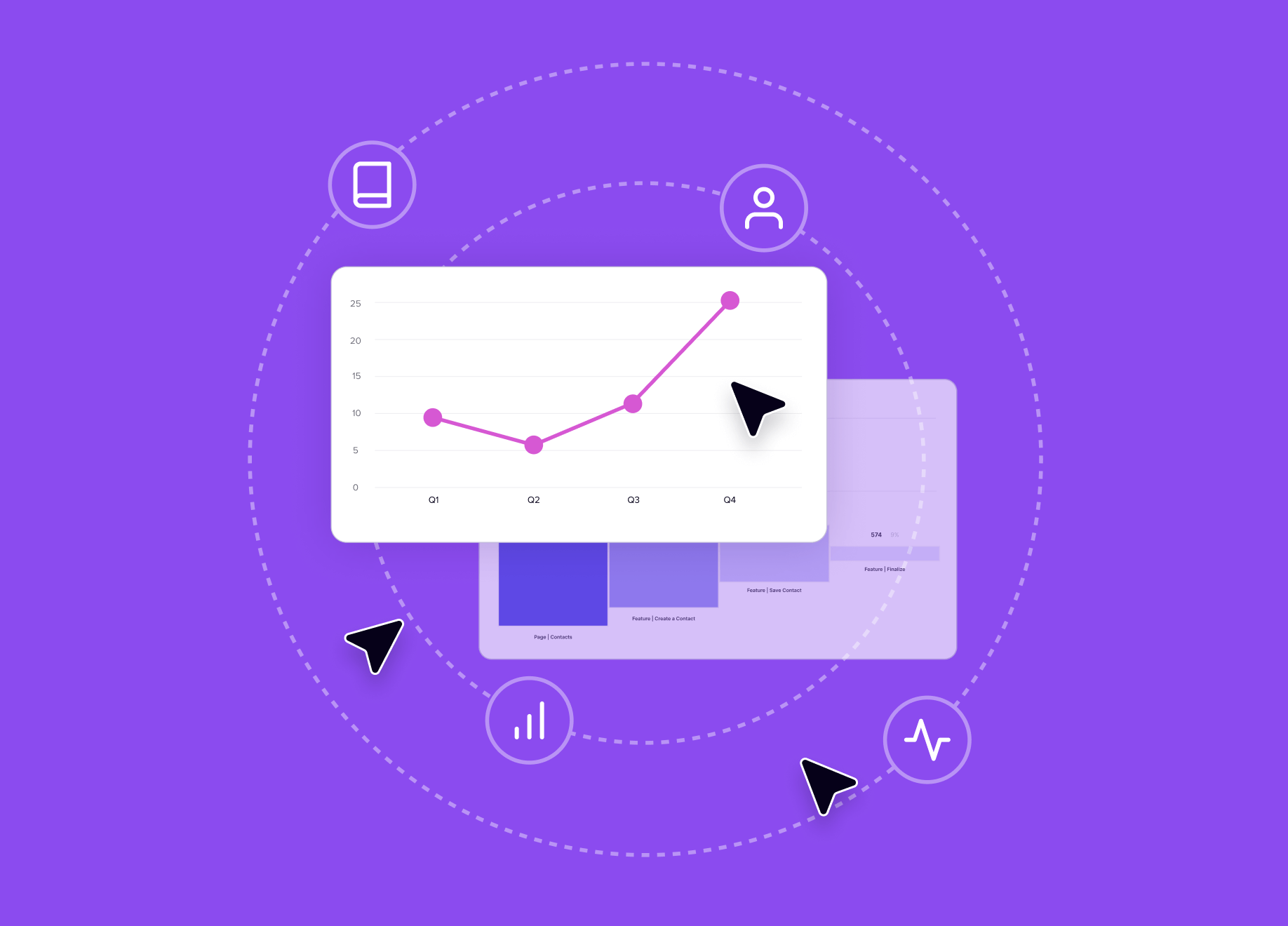目次
データプロダクトとは
データプロダクトは、再利用可能で自己完結型、かつユーザー中心のソリューションであるデータ資産のことで、対象となる消費者がすぐに使えるようにするために必要なツールと、関心のあるデータを束ねたものです。このようなデータプロダクトバンドルは、データアナリストや顧客向けアプリケーションが使用する内部ツールで、すべてがデータを活用して分析情報を提供し、ユーザー体験を向上したりタスクを自動化したりします。また、社内データプロダクトであろうと消費者向けデータプロダクトであろうと、ユーザーがデータ主導の意思決定を行えるようにする必要があります。
従来のデータ資産とは異なり、データプロダクトは単に生データへのアクセスを提供するだけではありません。データプロダクトは、キュレーションされたデータセットを取得し、関連するツールや機能と統合して、使いやすい方法で提示します。その結果、データプロダクトのユーザーは、特定のビジネス上の問題を解決したり、ユーザーのニーズに対応したりできるようになります。このパッケージ化されたアプローチ、つまりデータと、それを使用、分析、提示する手段を組み合わせることで、データプロダクトは再利用や販売が可能になります。
ここでは、データプロダクトの主な特徴をいくつか紹介します。
- ユーザーニーズへの重点化:データプロダクトは、ターゲットユーザーの特定のニーズを念頭に置いて設計されています。ユーザー体験(UX)を優先し、データを明確、簡潔、かつ実用的な形式で提示します。
- データのインテグレーション:データプロダクトは、多くの場合、複数のソースからのデータを組み合わせて、全体像を提供します。組み合わせプロセスには、社内データベース、エンタープライズアプリケーション(顧客関係管理、マーケティング自動化、またはその他の企業ドメインシステム)からのデータと、消費者の人口統計、ソーシャルメディアフィード、天気予報などの外部データソースのインテグレーションなどが含まれます。
- 実用的なインサイト:データプロダクトは、生データを提示するだけではありません。データ可視化ツール、インサイトを生成するための機械学習アルゴリズム、主要な傾向を強調する自動レポートなどの機能を提供することで、ユーザーがデータを理解できるようにする必要があります。
- 測定可能な影響:データプロダクトは、ビジネスに明確で定量化可能なメリットをもたらし、収益、顧客満足度(CSAT)、運用コストなどの主要なビジネス指標を改善する必要があります。
データプロダクトは「プロダクトとしてのデータ」と同義か
同じとも違うとも言えます。「プロダクトとしてのデータ」と「データプロダクト」という用語は混同されることがあります。関連性は非常に高いですが、次のような2つの違いがあります。
- プロダクトとしてのデータは、データを貴重な資産として扱い、そのガバナンス、アクセス、および使用にプロダクトマネジメントの原則を適用することを指す、より広い概念です。組織全体でデータを効果的に活用できるように、データの品質、セキュリティ、検出可能性を確保する必要があります。
- データプロダクトとは、「プロダクトとしてのデータ」の概念を具体化したものを指します。これは、データ(および関連ツール)を使用して特定のニーズに対応する自己完結型のソリューションのことです。
基本的に、「プロダクトとしてのデータ」は理念で、データプロダクトとは具体的な成果を指します。
データプロダクトと従来のソフトウェアプロダクトの違い
従来のソフトウェアプロダクトとデータプロダクトはどちらもユーザーの問題を解決することを目的としていますが、そのアプローチ方法は異なります。
- 従来のソフトウェアプロダクト:特定の機能セットを提供することに重点を置いています。ユーザー体験の優先事項は多くの場合、ユーザーが特定のタスクを完了できるか、特定の成果を達成できるかに絞られています。言い換えれば、ユーザーが実際にソフトウェアをどれだけ簡単に(そしてどれだけうまく)使いこなせるかは最重要事項ではありません。
- データプロダクト:データを活用して、特定の方法でユーザーを支援します。大規模なCRM、請求システム、その他の大規模なエンタープライズシステムに比べ、組み込まれている機能は(数的に)少ないかもしれませんが、ユーザーが特定の目的のために分析および行動できる方法でデータを提示することに重点が置かれています。
ちょっと面白い例えを紹介します。従来のソフトウェアプロダクトは調理済みの食事と考えることができます。ユーザーがタスクを完了する(食べる)ために必要なすべての材料(機能)と指示(ユーザーインターフェース)を提供してくれると捉えるのです。一方、データプロダクトは、品揃えの豊富なパントリーのようなものです。さまざまな食材(データ)とツール(分析)をユーザーに提供し、その時々の好み(ニーズ)に合わせた料理(インサイト)を作ることができるのです。
データ主導型のプロダクト開発とは:従来のプロダクト開発との違い
データ主導型のプロダクト開発(DDPD)は、ライフサイクル全体を通じてプロダクトの意思決定を通知するためにデータに大きく依存する開発手法です。従来のプロダクト開発との違いは以下のとおりです。
- 従来のプロダクト開発:多くの場合、直感、市場動向、顧客フィードバックに基づいてプロダクトを決定します。これらの方法は有益ですが、主観的で偏りが生じやすい場合があります。プロダクトマネージャーは、ユーザーが何を必要としているかについての独自の仮定に基づいて機能の優先順位を付けたり、顧客からのフィードバックプールで最も反響のあった意見に影響を受けたりします。
- データ主導型のプロダクト開発:さまざまなソースからの定量的データを活用して、プロダクトの意思決定を通知します。このデータには、ユーザー行動分析、A/Bテスト結果、顧客調査、市場調査レポートなどが含まれます。データを分析することで、プロダクトチームはユーザーのニーズについてより深いインサイトを得て、問題を特定し、プロダクトの仮説を検証(または無効化)できるようになります。
DDPDは反復的なプロセスです。チームは継続的にデータを収集して分析し、それらのインサイトを使用してプロダクトロードマップを改良し、機能に優先順位を付けます。その結果、よりユーザー中心でデータに基づいたプロダクト開発のアプローチが実現します。
データ主導型のプロダクト開発のメリットは次のとおりです。
- プロダクトマーケットフィットの向上:データを通じてユーザーの行動とニーズを理解することで、プロダクトがターゲット市場の共感を呼び、デジタルアダプションが進む可能性が高くなります。
- 開発リスクの軽減:プロダクトのアイデアをデータ主導で検証することで、ユーザーが実際には望んでいない、または必要としていない機能に時間とリソースを投資する可能性を減らすことができます。
- 効率性の向上:データ主導のインサイトに基づいて機能に優先順位を付けることで、チームはリソースをより効果的に割り当て、最大の価値を提供する開発作業に集中できます。
- プロダクト反復の迅速化:データを使用することで、継続的な測定と改善が可能になります。チームは改善すべき領域を迅速に特定し、データに基づいてプロダクトを調整することで、プロダクトの反復サイクルを短縮することができます。
- 意思決定の改善:データを使用することで、プロダクト開発プロセスから主観が排除されます。実際のユーザーデータに基づいて意思決定を行うことで、チームはユーザーのニーズをより適切に満たすプロダクトを開発し、最終的にプロダクトを成功に導くことができます。
データプロダクトロードマップのコアコンポーネント
データプロダクトロードマップとは、データプロダクトの開発パスを概説する戦略計画のことです。データを活用して機能の優先順位をつけ、スケジュールを定義し、プロダクトがビジネス目標やユーザーニーズに合致していることを確認することができます。
データプロダクトロードマップの6つの必須コンポーネントは次のとおりです。
- プロダクトのビジョンと目標:データプロダクトの長期的なビジョンと、達成を目指す具体的な目標を概説する明確で簡潔なステートメント。このビジョンは大胆でありながら達成可能であり、全体的なビジネス戦略につながるものでなければなりません。
- ユーザーペルソナ:データプロダクトを使用するユーザーとそのニーズを理解するためには、ターゲットユーザーペルソナを定義することが重要です。ユーザーペルソナは、インタビュー、アンケート、ユーザー行動分析など、実際のユーザー調査に基づいて作成する必要があります。
- 市場分析:現在の市場動向、消費者の嗜好、および全体的な競争環境を理解することは、データプロダクトを成功に導くのに役立ちます。このようなインサイトを得るためには、既存のソリューションを分析し、市場の潜在的なギャップを特定し、新しいテクノロジーや業界の傾向を常に把握しておく必要があります。
- 機能の優先順位付け:さまざまなソースからのデータを使用して、機能の開発に優先順位を付けます。機能の優先順位付けの一般的なフレームワークは、価値と労力の対比フレームワークです。理想的には、プロダクトチームによって最小限の開発労力でユーザーに高い価値を提供する機能(「クイックウィン」)が優先される必要があります。以下に、優先順位付けに使用されるデータポイントの例をいくつか示します。
- ユーザー調査:ユーザーインタビュー、アンケート、ユーザビリティテストにより、ユーザーの問題や必要な機能を明らかにできます。
- ユーザー行動分析:ウェブサイトまたはアプリケーション分析からのデータは、現在のプロダクトに対するユーザーインタラクションの詳細を示し、改善すべき領域を特定できます。
- A/Bテスト:さまざまな機能のバリエーションをテストすることで、どの機能が最もユーザーの共感を呼ぶかを把握できます。
- 市場調査:業界の傾向と競合他社のプロダクトを理解することで、データプロダクトの競争力を高めることができる機能を特定できます。
- タイムラインとマイルストーン:ロードマップは、機能を開発し、リリースするための現実的なスケジュールを設定する必要があります。ロードマップ全体で小さなマイルストーンを設定することで、チームは進捗状況を正確に監視し、プロジェクトをより適切なタイミングで完了させることができます。
- 指標と成功基準:データプロダクトのロードマップでは、プロダクトが目標を達成しているかどうかを判断するために、測定可能な成功基準を定義する必要があります。これらの指標には、以下のものが含まれます。
- ユーザー定着率:データプロダクトを積極的に使用しているユーザーの数。
- 機能エンゲージメント率:データプロダクト内の特定の機能を操作しているユーザーの割合。
- 顧客満足度スコア(CSAT):データプロダクトに対するユーザーの満足度を測定する指標。
- ビジネスKPI:収益の増加、顧客解約率の向上、コンバージョン率の向上など、プロダクトの目標に沿った重要業績評価指標。
これらの指標を長期にわたって追跡することで、プロダクトチームはデータプロダクトの有効性を評価し、必要に応じてロードマップを調整することができます。
データプロダクトロードマップを使用する利点
データプロダクトロードマップには、次のような重要な利点があります。
- プロダクトマーケットフィットの向上:データに基づいて機能開発の意思決定を行うことで、プロダクトが現在のユーザーニーズに対応し、関連する問題を解決するのに役立ちます。結果的に、プロダクトの定着化とユーザー満足度の向上につながります。
- データ主導の意思決定:データに基づいたロードマップは、プロダクト開発チーム内でデータ主導の意思決定の文化を促進します。定量化可能なデータに基づいて意思決定を行うことで、チームは主観や偏見を排除し、より効果的なプロダクト開発戦略を実現できます。
- リソースの最適化:データによって、プロダクトマネージャーは、その機能の潜在的な影響に基づき、機能の優先順位を決定できます。結果的に、チームはリソースを効率的に割り当て、ユーザーとビジネスに最高の価値を提供する機能に集中できるようになります。
- 調整と透明性:チーム間のコミュニケーションと調整を促進します。明確なビジョンとロードマップを提供することで、関係者はプロダクト開発の優先順位を理解し、貴重なフィードバックを提供できるようになります。
- 俊敏性の向上:データロードマップは、プロダクトマネージャーが新しいデータの発生に合わせて調整できる柔軟なドキュメントです。この柔軟性により、チームは進化するユーザーニーズや変化の激しい市場状況に俊敏に対応できるようになります。変更管理プロセスを実装すれば、ロードマップを適応させる際のスムーズな移行を確保できます。
データプロダクトロードマップの作成時に必要なデータの考慮事項
データプロダクトロードマップを構築するには、ユーザージャーニーとビジネス状況を包括的に把握する必要があります。考慮すべき各種データの内訳は以下のとおりです。
User research data
- ユーザーインタビューとアンケート:このような定性的な調査方法は、ユーザーのニーズ、問題点、および必要な機能に関するインサイトを提供します。
- ユーザー行動分析:ウェブサイトやアプリケーション分析ツールを通じて収集されたデータは、ユーザーの行動パターンを明らかにし、摩擦のある領域を特定し、十分に活用されていない機能を明らかにさせることができます。
- ユーザビリティテストと視覚的なデータ:セッションリプレイと再生(Pendoデジタルアダプションプラットフォームの一部)を介してユーザーのデータプロダクトの操作を観察することで、特定のユーザビリティの問題と改善すべき領域を特定できます。
定量的データ
- ウェブサイトとアプリケーションの分析:ウェブ分析データは、ユーザー獲得、エンゲージメント、コンバージョン率に関するインサイトを提供します。
- 顧客関係管理(CRM)データ:CRMシステムには、顧客の人口統計、購入履歴、サポートのやり取り、およびその他の顧客データが含まれています。このデータは、ユーザーセグメントを識別し、それに応じてデータプロダクトを調整するのに役立ちます。
- マーケティング自動化データ:マーケティング自動化プラットフォームからのデータは、マーケティングキャンペーンにおけるユーザー行動を明らかにし、データプロダクトの価値提案に関心のある潜在的なリードを特定することができます。
マーケティング調査データ
- 業界レポートとアナリストのインサイト:このようなリソースは、デジタルトランスフォーメーション(DX)が特定の業界にどのような影響を与えているかを示し、競合他社の分析、市場動向、データプロダクトに影響を与える可能性のある新技術などの貴重な情報を提供します。
- 顧客ベンチマークデータ:業界標準または競合他社のパフォーマンス指標に対するベンチマークは、改善すべき領域を特定し、データプロダクトの現実的な目標を設定するのに役立ちます。
さまざまなソースからの定性的、定量的、視覚的なデータを組み合わせることで、プロダクトチームは、ユーザーニーズに根ざし、ビジネス目標に沿った、市場の変化に対応するデータプロダクトロードマップを構築できます。データエコシステムが適切に機能することで、ロードマップの情報として使用されるデータが正確で信頼性が高く、必要な人がアクセスできるものになります。
ユーザーフィードバックをデータプロダクトロードマップに組み込む方法
ユーザーフィードバックは、データプロダクトロードマップにとって極めて重要な要素です。その組み込み方をいくつか紹介します。
- ユーザーインタビューとアンケート:ユーザーインタビューとアンケートを定期的に実施して、ユーザー体験、機能の提案、問題点に関するフィードバックを収集します。
- アプリ内フィードバックメカニズム:アンケート、投票、チャットボットなどの機能をデータプロダクト自体に実装し、ユーザーがリアルタイムのフィードバックを提供できるようにします。
- セッションの記録と再生:Pendoが提供するようなセッションの記録と再生ツールを利用して、ユーザーがデータプロダクトをどのように操作しているかを観察します。ユーザージャーニーにおける混乱や摩擦の領域を視覚的に特定することで、データプロダクトロードマップを策定し、改善に優先順位を付けるための貴重なインサイトを得ることができます。
- ユーザーコミュニティとフォーラム:ユーザーがデータプロダクトについて話し合い、アイデアを共有し、問題を報告することができるオンラインコミュニティやフォーラムを醸成します。
- ベータテストプログラム:ベータテストプログラムを実行して、より広範囲にリリースする前に新機能に関するユーザーフィードバックを早期に取得します。
ユーザーフィードバックを積極的に求めて取り入れることで、プロダクトチームは、データプロダクトロードマップが常にユーザー中心であり、変化し続けるユーザーニーズに確実に対応できるようにします。
Pendoがデータプロダクト開発のためのユーザー調査に役立つ仕組み
Pendoは、ユーザー調査とデータ収集のための堅牢なツールスイートを備えたデジタルプロダクト体験プラットフォーム(DPXP)を提供しており、データプロダクト開発チームにとって理想的なパートナーです。ここでは、Pendoがどのように役立つかをご紹介します。
- ユーザーセッションの記録:ユーザーセッションを収集することで、プロダクトチームはユーザーがデータプロダクトをどのように操作しているかを観察し、摩擦や混乱が発生する領域を特定することができます。
- ユーザー行動分析:データプロダクト内のユーザー行動に関する詳細なアナリティクスの提供により、最もよく使用されている機能、ユーザーのインターフェース操作方法、ユーザージャーニーにおけるユーザーの離脱場所を明らかにすることができます。
- ヒートマップとクリックストリームデータ:ヒートマップによって、データプロダクトのインターフェース上のユーザーのクリックとインタラクションが可視化され、ユーザーが重視する領域と潜在的な問題点に関する分析情報が提供されます。クリックストリームデータは、ユーザーがプロダクト内で実行する一連のアクションを明らかにし、ユーザーフローを特定して、ユーザー体験を最適化するのに役立ちます。
- フィードバックツール:Pendoは、アンケート、投票、アプリ内チャットなどのさまざまなフィードバックメカニズムを統合しているため、ユーザーはデータプロダクト内で直接リアルタイムのフィードバックを提供できます。
データプロダクトチームは、Pendoのユーザーリサーチ機能を活用することで、定性的、定量的、視覚的な豊富なデータを収集してロードマップの決定に役立て、データプロダクトでユーザー主導の体験を確実に提供できるようになります。
Pendoの機能を活用してデータプロダクトロードマップのデータを収集する方法
Pendoには、データプロダクトロードマップに必要な貴重なデータを収集するためのさまざまな機能が用意されています。
- ユーザーのセグメント化:人口統計、行動パターン、機能の使用状況などの基準でユーザーをセグメント化できます。このセグメント化は、データプロダクトの体験とロードマップを特定のユーザーニーズに合わせて調整するのに役立ちます。
- ファネル分析:ファネル分析ツールは、オンボーディングやデータ分析ワークフローなど、データプロダクト内の重要なジャーニーを通じてユーザーの進捗状況を追跡するのを支援します。このようなファネル内の離脱ポイントを特定することで、ボトルネックに対処する機能に優先順位を付け、ユーザーの完了率を向上させることができるようになります。
- A/Bテスト:Pendoを使用することで、さまざまなユーザーインターフェースのバリエーションや機能のA/Bテストを円滑に行えます。このようなテストを実施することで、データ主導の仮説を検証し、どのバージョンがユーザーの共感を最も得られるか判断し、将来のロードマップの決定に役立てることができます。
- リテンション分析:Pendoのツールは、データプロダクトに戻ってきたユーザーの数を経時的に追跡するのを支援します。このデータを使用することで、ユーザーエンゲージメントを促進する機能を特定し、ユーザーリテンションを向上させる取り組みに優先順位を付けることができるようになります。
これらのPendo機能を使用することで、データプロダクトチームはロードマップを改良し、ユーザー体験を最適化し、データプロダクトが長期的な価値を提供できるよう、実用的なユーザーデータを継続的に収集できます。
Pendoが理想的なソリューションである理由
Pendoは、以下のような方法でデータプロダクト開発チームを支援します。
- データ主導の意思決定:機能の優先順位付け、ユーザー体験の最適化、全体的なプロダクト戦略について情報に基づいた意思決定を行うためのデータとインサイトを提供します。
- ユーザー中心の開発:Pendoのユーザーリサーチツールを使うことで、データプロダクトロードマップがユーザーのニーズと問題に沿ったものになり、よりユーザー中心の満足感を与えるプロダクトになります。
- プロダクトマーケットフィットの向上:Pendoのデータ収集機能を通じてユーザーの行動と市場動向を理解することで、データプロダクトチームは実際の市場ニーズに対応するプロダクトを開発し、プロダクトとマーケットの確実な適合性を実現できます。
- 俊敏性の向上:PendoのユーザーフィードバックメカニズムとA/Bテストツールにより迅速な反復と適応が可能になるため、プロダクトチームはユーザーニーズや市場の変化に迅速に対応できるようになります。
- コラボレーションの強化:ユーザーデータとインサイトの一元的なプラットフォームを提供することで、プロダクトマネージャー、デザイナー、エンジニア間のコラボレーションを促進します。このコラボレーションにより、より合理化された効率的なプロダクト開発プロセスが実現します。
要するに、Pendoはデータプロダクト開発チームにとって重要なパートナーだと言うことです。Pendoの包括的なユーザーリサーチとデータ収集機能を活用することで、チームはユーザー中心のデータプロダクトを構築し、実際のビジネス上の問題を解決し、市場で長期的な成功を収めることができます。
Pendoによるプロダクト開発について学ぶ
さらに詳しく知りたい方は、Pendoのデータ同期をご覧いただくか、データ同期の使用方法を確認してください。
